An Introduction Flowers and Plants of Vietnam
By Alisha Falk
Vietnamese communities are very close to nature and local agriculture. In the south they harvest their food from the rivers, forests and family farms that span the southern tip of Vietnam. They depend on the richness and biodiversity of a tropical world so amazing that it is often referred to as one of the world’s richest ecosystems. Recently, I traveled with a group of University of Montana Students where we spent three and a half weeks exploring the Mekong Delta as well as natural areas around Ho Chi Minh City.
 During our stay, many of the meals we enjoyed have been as fresh as you could ever hope. Surprisingly, meals we’ve had incorporated many flowers, stems and roots. My classmates and I loved trying new and exciting foods. In the process, we have also had opportunities to learn about commonly used plants in Vietnamese cuisine and even some uncommonly used plants that may have medicinal value. The plants we learned were historically used by the indigenous Ma people, who reside outside of Cat Tien National Park, just north of Ho Chi Minh City.
During our stay, many of the meals we enjoyed have been as fresh as you could ever hope. Surprisingly, meals we’ve had incorporated many flowers, stems and roots. My classmates and I loved trying new and exciting foods. In the process, we have also had opportunities to learn about commonly used plants in Vietnamese cuisine and even some uncommonly used plants that may have medicinal value. The plants we learned were historically used by the indigenous Ma people, who reside outside of Cat Tien National Park, just north of Ho Chi Minh City.
In Vietnam, the lotus flower or the “Hoa sen” is so esteemed that it is seen in artwork, on temple walls, and in home gardens. The lotus is even found on your plate, where the petals are used to wrap sweet rice cakes, and the seeds are served as a side dish or are mixed into salads. The yellow center of the flower can be used to garnish tea cups. Sometimes, the flower is dried and steeped to make a delicious tea. Lotus tea is incredibly pleasant to sip while admiring the beauty of a Buddhist pagoda with your new local friends.
 The pumpkin flower, or the “bông bí”, is a little less stunning than the lotus, but is regularly eaten in hot pot meals or with beef and vegetables. The delicious male flower of the pumpkin plant is and harvested for cuisine because it doesn’t produce fruit. Bông bí is very popular and packs a lot of flavor. When we tried it, a few of us thought that it tasted similar to spinach. It was surprising to learn that farmers can usually get more money for flowers than they can for actual pumpkins.
The pumpkin flower, or the “bông bí”, is a little less stunning than the lotus, but is regularly eaten in hot pot meals or with beef and vegetables. The delicious male flower of the pumpkin plant is and harvested for cuisine because it doesn’t produce fruit. Bông bí is very popular and packs a lot of flavor. When we tried it, a few of us thought that it tasted similar to spinach. It was surprising to learn that farmers can usually get more money for flowers than they can for actual pumpkins.
 Water hyacinth, an invasive plant species to Vietnam, has been increasingly incorporated into Vietnamese daily life. During our adventure we never ate the flower, but we did eat the stems. Stems are versatile can be woven into baskets or mats. Like the bông bí, stems are tossed into hot pot soups. Amazingly, hyacinth has been found to be a good resource for making biofuel, through a process of collecting methane gasses produced by the decomposition of organic materials. The gas can be used to fuel kitchen stoves for rural farmers and is a sustainable source of energy.
Water hyacinth, an invasive plant species to Vietnam, has been increasingly incorporated into Vietnamese daily life. During our adventure we never ate the flower, but we did eat the stems. Stems are versatile can be woven into baskets or mats. Like the bông bí, stems are tossed into hot pot soups. Amazingly, hyacinth has been found to be a good resource for making biofuel, through a process of collecting methane gasses produced by the decomposition of organic materials. The gas can be used to fuel kitchen stoves for rural farmers and is a sustainable source of energy.
 If you find yourself in Vietnam, and you travel a little bit north of Ho Chi Minh City, you would find it wonderfully enriching to stay at Ta Lai Longhouse, where we had an opportunity to learn about the Ma people. We were lucky enough to visit with an amazing woman named Ka Huong. During our stay she graciously introduced us to her culture and the local ecosystem.
If you find yourself in Vietnam, and you travel a little bit north of Ho Chi Minh City, you would find it wonderfully enriching to stay at Ta Lai Longhouse, where we had an opportunity to learn about the Ma people. We were lucky enough to visit with an amazing woman named Ka Huong. During our stay she graciously introduced us to her culture and the local ecosystem.
Ka Huong guided us on a thirteen kilometer hike through the Vietnamese jungle.  Along the way, she invited us to taste an interesting Licorice vine called “cam thảo” or Glycyrrhiza uralensis. Licorice vine is not the same thing that you would extract anise from, but it tastes similar. The vine, when chopped into tiny pieces can be chewed like gum. It has a potent, sweet flavor, and Ka Huong told us that it will help us to forget that we are thirsty, which could be nice while trekking through the hot and humid jungle, while on our way to explore local bat caves.
Along the way, she invited us to taste an interesting Licorice vine called “cam thảo” or Glycyrrhiza uralensis. Licorice vine is not the same thing that you would extract anise from, but it tastes similar. The vine, when chopped into tiny pieces can be chewed like gum. It has a potent, sweet flavor, and Ka Huong told us that it will help us to forget that we are thirsty, which could be nice while trekking through the hot and humid jungle, while on our way to explore local bat caves.
 Deeper into the jungle we encountered beautiful white barked trees, which Ka Huong called “bang lang”. These enormous trees are some of the most beautiful trees you might ever see, with pearly white bark that appears to have been chipped at with a sharp tool. The trees are often hollow due to termite invasions, and in the past the Ma people used hollow trunks to make coffins. The bark was also traditionally used to make a tea that was effective in treating diarrhea. Today, the trees are protected and they no longer harvest them.
Deeper into the jungle we encountered beautiful white barked trees, which Ka Huong called “bang lang”. These enormous trees are some of the most beautiful trees you might ever see, with pearly white bark that appears to have been chipped at with a sharp tool. The trees are often hollow due to termite invasions, and in the past the Ma people used hollow trunks to make coffins. The bark was also traditionally used to make a tea that was effective in treating diarrhea. Today, the trees are protected and they no longer harvest them.
If you were describing Vietnam to someone who has never seen it, you might find it helpful to compare the country to a lotus flower. Vietnam is like a grand, fragrant flower that has been admired throughout history. To people around the world, the lotus represents beauty that has grown upward toward the sky from being deeply rooted and buried in the mud. Symbolically the lotus reminds us that out of the darkness there is always light, life, and love. From the muddiest of challenges, Vietnamese people have always found ways to bloom and enrich the world. Our short stay was full of memorable experiences and interactions with the local people and environments. We often shared stories during dinner, and most importantly, we made many new wonderful friends with the help of the lotus flower.
Women of the Mekong
By Mattie Lehman
As I look out over my breakfast at the river in Can Tho, the sun creates a striking silhouette of a woman in a rice paddy hat standing at the motor of her boat. Chances are she spent the morning at the floating market selling or stocking up on fruits and vegetables for a small business. Our experience in Vietnam so far suggests this entrepreneurial mystery woman is not unique.

After reading one article, I came to Vietnam falsely expecting to find women primarily fulfilling duties of the home. I do not want to make the same mistake in writing this. The unique history of communism, female soldiers, agrarian lifestyles, and modernization make the role of women in Vietnam more nuanced than I can understand in a few weeks. Rather than generalizing about an entire population from limited experience, I would like to profile a few of the women I have met and let them stand on their own.

In our first week in Can Tho I had the privilege of spending an evening dinner in conversation with Dua, a remarkable woman in a very similar life stage as my own. We talked of romantic relationships, education, and our families.
In our mid-twenties and single, we both try to navigate the complications of modern dating. We must determine if that really nice guy we met is interested and straight or friendly and gay. We become frustrated by cultural stigmas about “over-educated” women. We struggle with the idea of online dating to meet people. While many of our concerns are the same, we differ in one key area. The female teaching assistants on our trip have claimed that in Vietnam, people expect that women will settle by age 30. This cultural norm adds a whole other layer of pressure to Dua’s dating life than my own.
Dua surprised me with another major difference when I complimented her motorbike. She told me it was a gift from her mother, but clarified with a laugh, “Well, a gift from my mother with my money.” Very much unlike myself, at the age of 26, Dua’s income helps support her family who farm shrimp in the south western region of Vietnam.
Dua has earned her Masters degree in Biology and teaches at Can Tho University. She is currently in the process of applying to attend school in Japan in pursuit of a PhD.

Son Island Farmer
When traveling to Son Island to observe ecotourism development, a female farmer led us around the island. We talked with her about the impacts of climate change on farm production and the switch to supplementing her income through tourism. While looking at her crops, someone commented on how good the fruit looked. Within a few moments we turned to see her barefoot, in a tree pulling down pomelos for our lunch. We sat down tired and hungry to a wonderful meal cooked by family members and served by her and her husband. The pomelos were my favorite part of the meal.
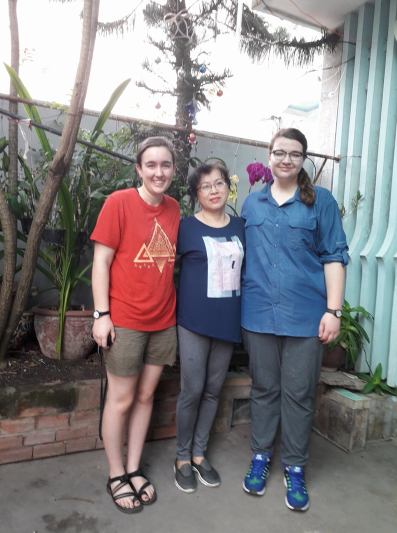
Ms. Lan with Mattie and Emma
Four times a day six days a week Ms. Lan runs an English school out of her front room. All her students treat her with the utmost respect, and she talks of attending their weddings and other important life events. She keeps herself busy between classes and taking care of her household of husband, daughter, son-in-law, and grandchild. Last weekend she hosted myself and Emma Kiefer—learning to cook vegetarian food just for our visit. Every evening after classes she takes some time to herself to go for a walk around the park.
Ms. Lan’s daughter, Thuy, is a chemical engineering professor at Can Tho University. She keeps herself busy balancing work life and taking care of her 3 year old son. Thuy talked with me at length about the state of women in academia. She praised the sixth month maternity leave she expects when her second child is born, but also explained how, similar to the United States, the demands of home life can cause women to miss out on promotions and leadership opportunities. Thuy feels grateful for her family but concerned for fellow PhD holding friends who want families. Female academics often have trouble finding partners who are comfortable dating a more powerful and educated woman. Contrarily, those qualities make a man more desirable.
These four represent only a few of the roles women play in Vietnam. We have also met shopkeepers, scantily clad beer girls, rice and shrimp farmers, tour guides, bankers, traffic officers, national park experts, hotel maids, receptionists, and mothers.

The Giants that live within the Nine Dragons
By Taylor Chenette
The nine dragons of southern Vietnam breathe in and out twice a day during the dry season. During the monsoon season, the dragons only breath in and out once a day. The breaths are the tidal exchange of fresh and salt water, from river to sea. The dragons represent the major tributaries of the Mekong Delta; in Vietnamese: Đồng bằng Sông Cửu Long, or River of Nine Dragons. Within those dragon breaths, giant aquatic species migrate in and out.
In scientific terms, a species must be capable of growing to at least two metres [6.6 ft.] in length or 100kg [220.5 lbs.] in weight to qualify as a giant fish.
–World Wildlife Fund.
Four of world’s most giant fresh water fish are found in the Mekong River. The first is the Giant Freshwater Stingray (Himantura chaophraya) which can weigh up to 1322.77 lbs. (600 kg), then the Mekong Giant Catfish (Pangasianodon gigas) with a max recorded weight of 771.6 lbs. (350 kg) followed by the Dog-eating catfish (Pangsius sanitwongsei) and the Giant Barb (Catlocarpio siamensis), both with a max weight of 661.4 lbs. (300 kg).



 The existence of these giants is ecologically and culturally significant. They are vulnerable to changes in river conditions and flow, and several are endemic to the Mekong. Around 87% of the Mekong’s known aquatic species, including the giants, are migratory. They rely on different segments of the river for variation in habitat and brackish or freshwater, based on their life-stage. The river, and its diverse migratory species, are threatened by hydropower dam infrastructure. Dams obstruct sediment transportation, water flow rates, and tributary connectivity – all key characteristics of the Mekong’s habitat. There are currently 12 proposed dam projects for the lower Mekong.
The existence of these giants is ecologically and culturally significant. They are vulnerable to changes in river conditions and flow, and several are endemic to the Mekong. Around 87% of the Mekong’s known aquatic species, including the giants, are migratory. They rely on different segments of the river for variation in habitat and brackish or freshwater, based on their life-stage. The river, and its diverse migratory species, are threatened by hydropower dam infrastructure. Dams obstruct sediment transportation, water flow rates, and tributary connectivity – all key characteristics of the Mekong’s habitat. There are currently 12 proposed dam projects for the lower Mekong.

The 1990’s saw a major shift from fishing to aquaculture due to several factors including, but not limited to, over harvesting of wild fish populations, an increase in human populations and demands for fish supply, and new developments in aquaculture technology. A species of pangasius, or catfish, is common choice for aquaculture. Vietnam provides over 90% of the world’s catfish exports. Escaped farmed fish, developed from cultures, pose a threat to wild fish via cross-breeding, disease spread, and competition for habitat. Scientists at Can Tho University are researching and developing immunizations to decrease disease risks.
 Fish disease researcher checks on the status of her catfish barrels.
Fish disease researcher checks on the status of her catfish barrels.
The Mekong is second to the Amazon river in biodiversity. Over 1,200 freshwater species inhabit its waters, with over 45 new species of fish discovered between 1992 and 2004. The river produces around 2.6 million tons of fish per year, making it the most productive inland fishery in the world. Conservation and protection of this mighty river is important, especially as there is plenty to still be discovered and understood about the Mekong and its nine dragons.
To Shrimp or Not to Shrimp?
By Savannah Stewart
Vietnam is the 8th largest shrimp exporter in the world. More and more people in the Mekong Delta rely on shrimp aquaculture as their many source of income.  The question on my mind when we started this trip was: can shrimp farming be sustainable and eco-friendly? After traveling around the Delta the last few weeks, the answer seems to be “Yes”.
The question on my mind when we started this trip was: can shrimp farming be sustainable and eco-friendly? After traveling around the Delta the last few weeks, the answer seems to be “Yes”.
We learned about several farming techniques that reduce the impact of shrimp farming on the environment, while still ensuring the farmers’ livelihoods. This balance between sustainability and profitability must endure to allow people to make the transition to environmentally-sound aquaculture.
Deep in the mangroves of Can Gio, we experienced our first lesson with a shrimp farmer. The farmer uses an integrated mangrove-shrimp system that allowed him to take advantage of the natural ebb and flow of the tide to grow and harvest wild shrimp and fish.  A gate controls the flow of water and creatures into or out of the shrimp pond. When the tide comes in, he opens the gate and allows water and young shrimp into the pond. These shrimps grow until it’s time to harvest them. Because the farm lies among the mangroves, he signed a government contract swearing to protect a certain amount of the forest on his land. For this he receives a stipend for each hectare of protected mangrove. In this way, he conserves the integrity of the forest while benefiting from the services mangroves provide to the shrimp (like nutrient cycling, water purification, etc.). This decreases the negative impacts of clearing mangroves for aquaculture and provides a sustainable method for harvesting shrimp.
A gate controls the flow of water and creatures into or out of the shrimp pond. When the tide comes in, he opens the gate and allows water and young shrimp into the pond. These shrimps grow until it’s time to harvest them. Because the farm lies among the mangroves, he signed a government contract swearing to protect a certain amount of the forest on his land. For this he receives a stipend for each hectare of protected mangrove. In this way, he conserves the integrity of the forest while benefiting from the services mangroves provide to the shrimp (like nutrient cycling, water purification, etc.). This decreases the negative impacts of clearing mangroves for aquaculture and provides a sustainable method for harvesting shrimp.
Another farming system we learned about is alternative shrimp-rice farming. In this method, farmers use the dynamic wet-dry seasonality of the Delta to grow shrimp and rice at the best time of year. 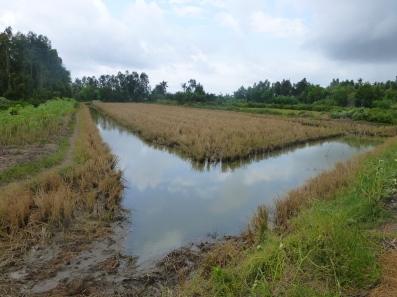 During the dry season, when brackish water comes in, the farmers raise shrimp. In the rainy season the fields fill with freshwater, which allows for rice to grow. Depending on the type of shrimp, farmers can get one or two crops of shrimp and one crop of rice. Other aquatic organisms such as freshwater prawn and local fish can be raised in the rainy season. The addition of aquaculture adds augments the farmer’s income as well as diversifies the farm.
During the dry season, when brackish water comes in, the farmers raise shrimp. In the rainy season the fields fill with freshwater, which allows for rice to grow. Depending on the type of shrimp, farmers can get one or two crops of shrimp and one crop of rice. Other aquatic organisms such as freshwater prawn and local fish can be raised in the rainy season. The addition of aquaculture adds augments the farmer’s income as well as diversifies the farm. 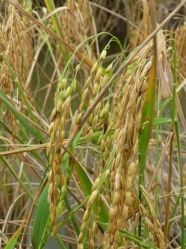 In a way, the farmer creates a sort of artificial ecosystem that is far more resilient than a monoculture of either rice or shrimp.
In a way, the farmer creates a sort of artificial ecosystem that is far more resilient than a monoculture of either rice or shrimp.
While these types of farms occur throughout the Mekong Delta, the movement towards sustainable shrimp farming has a long way to go. On our trek through Vietnam, we tended to visit shrimp farms that embraced the shift towards environmentally sustainable practices.  However, the vast majority of shrimp aquaculture in the Delta follows traditional intensive farming methods. This type of shrimping does not incorporate shrimp with any other crop, uses higher amounts of fertilizer and pesticides, and overall has higher production costs. Dr. Tran Ngoc Hai explained that intensive farming also harbors environmental and disease-related issues because of the high density of stocked shrimp and the invasive nature of the operation. This farming method drains the land and results in unsustainable use of natural resources that cannot continue into the future.
However, the vast majority of shrimp aquaculture in the Delta follows traditional intensive farming methods. This type of shrimping does not incorporate shrimp with any other crop, uses higher amounts of fertilizer and pesticides, and overall has higher production costs. Dr. Tran Ngoc Hai explained that intensive farming also harbors environmental and disease-related issues because of the high density of stocked shrimp and the invasive nature of the operation. This farming method drains the land and results in unsustainable use of natural resources that cannot continue into the future.
While unsustainable practices still exist, the farmers of Vietnam show us that shrimp can be raised sustainably. To achieve this, intensive farming must be phased out in favor of mixed farming methods like those described above. Hopefully, with better education we can create a fully sustainable system of aquaculture in the Mekong Delta that can support both the people and the environment.
Climate Change: A Shift in the Conversation
By Maddie Broom
The Vietnamese people have always had a close relationship with nature. Many of their cultural symbols incorporate nature and agriculture is still a large part of the culture. 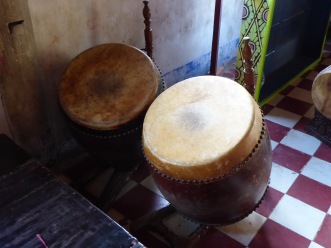 Bronze drums are very important as they’re symbols of authority and hold religious significance. These drums differ in shape and pattern. Concentric circles on a drum represents unity and communication between people and nature.
Bronze drums are very important as they’re symbols of authority and hold religious significance. These drums differ in shape and pattern. Concentric circles on a drum represents unity and communication between people and nature.
Climate change is complicating the conversation between people and their environment. 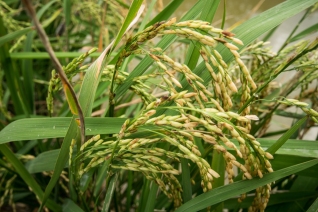 Rice, another cultural symbol representing humans conquering nature, is now conquering humans. Saline intrusion due to sea level rise is making it harder to raise rice crops which require fresh water to thrive. Rice is a staple food in the Vietnamese diet and makes up almost half of what I have been eating since arriving in Vietnam.
Rice, another cultural symbol representing humans conquering nature, is now conquering humans. Saline intrusion due to sea level rise is making it harder to raise rice crops which require fresh water to thrive. Rice is a staple food in the Vietnamese diet and makes up almost half of what I have been eating since arriving in Vietnam.
The Vietnamese people are slowly learning to recognize what is happening. According to Dr. Vo Quoc Tuan, an understanding of climate change has grown from less than 20% in 2008 to about 70% during the most recent survey in 2017. Although an understanding of climate change is spreading it’s still often far from the mind because as Dr. Le Khuong Ninh, an economist at Can Tho University said, the Vietnamese in the Mekong Delta live an “easy life” with fertile soil and an abundance of fauna, but this is beginning to change.
Ms. Nhi Thoi with Change Vietnam said that identifying the effects of climate change as such is an important step in trying to combat the cause of the problem. People need to understand the impacts they are seeing are caused by human actions and aren’t simply natural occurrences. Only until people recognize that fact can we attempt mitigation strategies. Nhi said that the Vietnamese government is much more open to adaptation attempts rather than mitigation. Although Vietnam is facing a large portion of the effects from a hotter climate, rising sea levels, and changing rain fall patterns it has contributed very little to greenhouse gas emissions.
 It might be hard to see change when attempting to inspire a nation at an NGO which is strictly regulated by the Vietnamese government, but when visiting with farmers and speaking to professors a shift in attitudes can be seen. Most of the climate change work is happening on the provincial level. Action plans have been created, climate change is beginning to be integrated into development plans, pilot projects are taking place, and climate change workshops are in place to educate the community.
It might be hard to see change when attempting to inspire a nation at an NGO which is strictly regulated by the Vietnamese government, but when visiting with farmers and speaking to professors a shift in attitudes can be seen. Most of the climate change work is happening on the provincial level. Action plans have been created, climate change is beginning to be integrated into development plans, pilot projects are taking place, and climate change workshops are in place to educate the community.
 Agricultural shifts are the biggest adaptation we have seen while being in Vietnam. Farmers are shifting from intensive mono cropping which promotes disease and is high risk economically to extensive crops that alternate throughout the year. A few days ago in Bac Lieu we met a farmer who alternated rice and shrimp crops. Rice is planted during the rainy season when there is plenty of fresh water. During the dry season the dikes are opened to allow in brackish, saline water to grow shrimp. This shift in farming is an adaptation to the rising water levels and changing rain patterns are responsible for the saline intrusion. The farmer learned about this method of farming from informational pamphlets around town and advertisements that the government runs on TV. The region and province have training courses to show farmers how to switch and Can Tho University offers some training courses as well. Dr. Hai, with Can Tho University, said there are at least two stories on climate change on TV every week which is more than you see in the US.
Agricultural shifts are the biggest adaptation we have seen while being in Vietnam. Farmers are shifting from intensive mono cropping which promotes disease and is high risk economically to extensive crops that alternate throughout the year. A few days ago in Bac Lieu we met a farmer who alternated rice and shrimp crops. Rice is planted during the rainy season when there is plenty of fresh water. During the dry season the dikes are opened to allow in brackish, saline water to grow shrimp. This shift in farming is an adaptation to the rising water levels and changing rain patterns are responsible for the saline intrusion. The farmer learned about this method of farming from informational pamphlets around town and advertisements that the government runs on TV. The region and province have training courses to show farmers how to switch and Can Tho University offers some training courses as well. Dr. Hai, with Can Tho University, said there are at least two stories on climate change on TV every week which is more than you see in the US.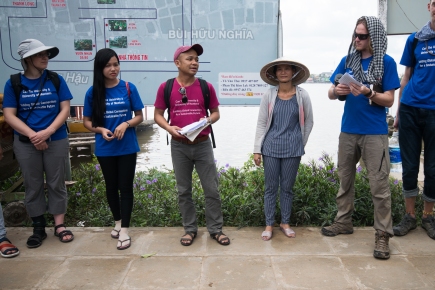
Climate change is an issue that Vietnam cannot ignore and the Vietnamese are learning that as well. Their conversations with the land are changing and adapting to a new climate. In the United States we might take a cue from the Vietnamese and start up a conversation with our natural environment.
The Floating Markets of Can Tho
By Dominique Nault
The Mekong Delta is one of the most fertile agricultural lands in Vietnam because of the nutrient rich soil that is brought down from Tibet. Most of the residents in the delta are farmers and when I drove in between the city streets to meet with my home stay family I noticed almost every house had a garden that grew numerous fruits and vegetables. There are many markets or street vendors trying to sell their produce so one of the ways to sell items are on boats at 4am on the Mekong River.

In Can Tho city you can enjoy the sunrise on the Mekong River while watching the river come to life with farmers trying to sell their produce on small boats. Although the sun has not yet come up, the heat still lingers from the previous day and humid air makes wearing a cotton shirt difficult.  To locals the weather was a perfect time to sell their produce that they spent harvesting in the rainy season. The floating market could potentially bring in 10 million dong ($440 USD) every month to the local economy.
To locals the weather was a perfect time to sell their produce that they spent harvesting in the rainy season. The floating market could potentially bring in 10 million dong ($440 USD) every month to the local economy.
As we gathered on the boat I noticed that there were other 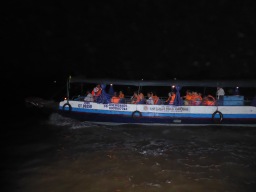 foreigners that woke up early to see the floating market. I was surprised to see so many tourists but was also excited because I believe that Vietnam is a beautiful place that everyone should explore.
foreigners that woke up early to see the floating market. I was surprised to see so many tourists but was also excited because I believe that Vietnam is a beautiful place that everyone should explore.  When we moved up the river, a smaller boat latched itself on us and it began to feel like a pirate movie and were about to take over our ship.
When we moved up the river, a smaller boat latched itself on us and it began to feel like a pirate movie and were about to take over our ship.
In the Mekong Delta, many different plants and species rely on the river because of its capacity to provide biodiversity and nutrients. Vietnam is a beautiful landscape that can grow a pleather of different fruits and vegetables and seeing them stacked up on boats was memorizing and I forgot that we were there to purchase from the locals.
 I got a completely different perspective when I stayed with a local family that lived in the Mekong Delta for generations. They stated that the floating market used to be so huge that police would have to tell some farmers in boats to pull to the side and wait until more boats passed. Due to the development in Vietnam the roads are now used to transport the produce rather than the river.
I got a completely different perspective when I stayed with a local family that lived in the Mekong Delta for generations. They stated that the floating market used to be so huge that police would have to tell some farmers in boats to pull to the side and wait until more boats passed. Due to the development in Vietnam the roads are now used to transport the produce rather than the river.  Although the floating market was still beautiful and interesting, I would have really loved to see that many boats in the middle of the river.
Although the floating market was still beautiful and interesting, I would have really loved to see that many boats in the middle of the river.
The floating market was definitely a unique experience that people need to visit soon otherwise I am not sure how it will look in the next couple years due to the development.  Any kind of infrastructure in a developing country is a great but there is also some uniqueness that the country will lose, and they need to find a balance with preserving some of the features such as the floating market. Riding a boat along the Mekong River and purchasing things such as souvenirs or fruits and pho while the sun rises is something that a lot of tourists and locals will appreciate.
Any kind of infrastructure in a developing country is a great but there is also some uniqueness that the country will lose, and they need to find a balance with preserving some of the features such as the floating market. Riding a boat along the Mekong River and purchasing things such as souvenirs or fruits and pho while the sun rises is something that a lot of tourists and locals will appreciate.
Youth Involvement and Climate Change
By Emma Kiefer
It’s not always easy to find hope with the current state of global affairs. This population of humans faces more complex, dynamic, and ethical issues than ever before, the most concerning of those being climate change.
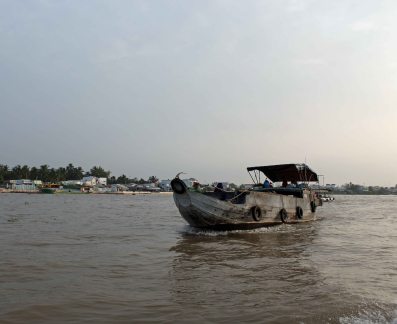
Of the populations affected by climate change, children and young adults are some of the most vulnerable. In a UNICEF report entitled “Unless we act now”, outlines the ways that young people are more exposed to the risks of climate change, saying that “the youngest will have to contend with the immediate and life-threatening dangers of climate-related disasters, food insecurity, rising air pollution, increased risk of vector-borne diseases, acute repertory infections, diarrheal diseases and malnutrition”.

It’s difficult to find an optimistic outcome to this situation, but the young people who are faced with severe environmental challenges are more than ready to step up to the table. The last two weeks in Vietnam have been incredible because so many of our teaching assistants and groups we’ve met with have been young people who want to make a positive change.
One of the first groups we met with was Green Vietnam.  The three young people from this group had such a clear concern for the environment, but also an attitude that made me believe that something could actually be done. What was it that made these people so hopeful?
The three young people from this group had such a clear concern for the environment, but also an attitude that made me believe that something could actually be done. What was it that made these people so hopeful?

Another incredible group we met with for three days was the Delta Youth Alliance (DYA). We spent a day at Can Tho University (CTU) sharing presentations on environmental issues in both the Mekong Delta and Montana. It was surprising to me how many talks were focused on young people in the region.
 This dynamic group of students from CTU showed me that hope is possible, and it is reasonable.
This dynamic group of students from CTU showed me that hope is possible, and it is reasonable.
Vietnam is a rapidly growing, young country, with about 40% of the population between 0 and 24 years old, according to Index Mundi. There is so much potential with such a “young” country like Vietnam that it would be foolish to not empower, educate, and motivate youths to pursue a global change in action towards climate change.

The DYA also showed a remarkable amount of resourcefulness and enthusiasm. Not only did these students genuinely care about environmental issues, but they had the ability to research information and work on solutions of their own.
From meeting with the DYA, I noticed how our group from UMT wasn’t all that different from them. We too, were passionate about climate change, and by traveling across an ocean we all showed we were willing to take action. Seeing how these groups interacted made me hopeful for the future, because I know that inaction is not an option with them.

While none of us can say exactly what will happen in the coming years, it is important to recognize that the current and future groups of young adults will bear the responsibility to tackle climate change. When making local plans to combat climate change, it is vital that we include ways to prepare for the massive challenges that the newest, and future generations, will face.
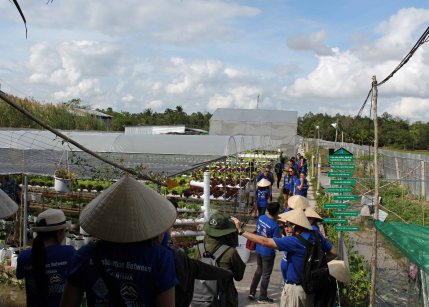
Urban flooding issues and flood tolerance in Vietnam
By Tom Donahue
It’s not every day that your city streets turn into a canal system that makes you set aside the motorbike and take out the canoe. Bordering the Tropic of Cancer in the north and the equator in the south, Vietnam gets between 60 and 100 inches of precipitation each year.  Combined with the two delta river systems that drain the Himalayan mountains and direct precipitation, Vietnam’s natural environment is adapted for the most dramatic influx of water than anywhere else on Earth. Paired with clay soil and dense vegetation, the system can tolerate variable weather, but anthropogenic perturbations have lessened the system’s resiliency.
Combined with the two delta river systems that drain the Himalayan mountains and direct precipitation, Vietnam’s natural environment is adapted for the most dramatic influx of water than anywhere else on Earth. Paired with clay soil and dense vegetation, the system can tolerate variable weather, but anthropogenic perturbations have lessened the system’s resiliency.
 The urban environment in Vietnam, as it is built today, has blanketed the soil and removed the vegetation. Impermeable infrastructure like asphalt roads and concrete buildings have replaced much of the permeable environment leaving green spaces and drainage systems to absorb or funnel the storm water underground or to the ocean. Even the rural areas we have visited are increasingly removing native vegetation and paving over the landscape. Impermeable surfaces in Vietnam are putting public health, the environment, and the economy at risk by increasing polluted water, land use changes, and costs from flood damages, respectively.
The urban environment in Vietnam, as it is built today, has blanketed the soil and removed the vegetation. Impermeable infrastructure like asphalt roads and concrete buildings have replaced much of the permeable environment leaving green spaces and drainage systems to absorb or funnel the storm water underground or to the ocean. Even the rural areas we have visited are increasingly removing native vegetation and paving over the landscape. Impermeable surfaces in Vietnam are putting public health, the environment, and the economy at risk by increasing polluted water, land use changes, and costs from flood damages, respectively.
The streets are littered with packaging and food scraps from daily activities; and oils from places like motorbike shops are washed into the streets nightly. Vietnam has yet to have a Lady Bird Johnson of their own to campaign against street littering or proper disposal of toxic chemicals. 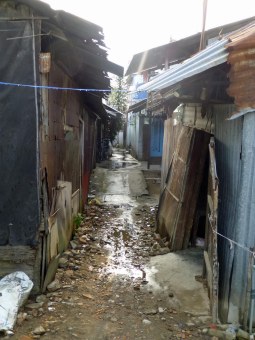 Industrial waste is less regulated, which contributes to unsafe levels of chemical discharge and emissions whose impacts are felt locally.
Industrial waste is less regulated, which contributes to unsafe levels of chemical discharge and emissions whose impacts are felt locally.
When the rains come, the drainage systems reach capacity quickly when the rivers overflow. Locals say the street trash clogs storm drains frequently, which increases the amount of water on the streets and prolongs inundation.  Most Vietnamese do not own cars; they own motorbike, bicycles, or walk, so many people are exposed to a mixture of storm water and pollutants that may cause skin allergies. Climate change will increase the severity of rain events that exacerbates rapid flooding and prolonged inundation.
Most Vietnamese do not own cars; they own motorbike, bicycles, or walk, so many people are exposed to a mixture of storm water and pollutants that may cause skin allergies. Climate change will increase the severity of rain events that exacerbates rapid flooding and prolonged inundation.
Impermeable surfaces rely on drainage systems to remove flood water from those surfaces, but an inefficient system increases the time water lays stagnant. Most streets and sidewalks in Vietnam are not ADA certified (fit for wheelchairs) meaning potholes, large cracks, and divots sprinkle the streets. Depressions in the streets that fill with stagnant water are suitable environments for mosquitos to reproduce, and may lead to an increase of dengue fever. Leaving Ho Chi Minh City in the bus, urban sprawl was apparent seeing large bridges, roads, and buildings under construction continuous for an hour from the city center. As deforestation and impermeable surfaces increase, the surrounding environment is losing its capability to effectively manage flooding favoring some wildlife over others.
New Year’s Eve was a direct look at Vietnams traffic potential; there was bumper to bumper motorbike traffic for seven hours with dry streets. The streets have potential to hold a foot or two of water during the rainy season, which slows traffic considerable. Having only seen pictures and water stains on the sides of buildings, one can only imagine how difficult it would be finding traction. Sitting lower than the average car, motorbike exhaust pipes make the motorbike susceptible to suffocation and engine failure. With dozens of immobile motorbikes, it makes transportation extremely burdensome. The economy suffers a great deal from restricted activities during the floods and the cost of reconstruction when the water subsides.
 Vietnam cannot stop the flooding; it is engrained into the culture and the landscapes. However, increasing permeable surface area with different paving techniques or increasing green space will prevent disease, replenish groundwater, and reduce inundation and costly centralized storm water system upgrades.
Vietnam cannot stop the flooding; it is engrained into the culture and the landscapes. However, increasing permeable surface area with different paving techniques or increasing green space will prevent disease, replenish groundwater, and reduce inundation and costly centralized storm water system upgrades.
Energy from the Garden to the Kitchen
By Ming Harris-Weidner 
Located outside of Can Tho’s center, lies a commune of farmers called My Khanh.  A small dirt road, just wide enough for two motorbikes, winds through My Khanh and mirrors the path of the river that provides substance for the farmers living there. Large flowering fruit trees cast a refreshing shade over the soft ground and our group walks excitedly to our set location. As we walk, we wave to farmers and observe their simple, open air dwellings.
A small dirt road, just wide enough for two motorbikes, winds through My Khanh and mirrors the path of the river that provides substance for the farmers living there. Large flowering fruit trees cast a refreshing shade over the soft ground and our group walks excitedly to our set location. As we walk, we wave to farmers and observe their simple, open air dwellings.
Just by looking at the beautiful scenery and friendly faces that inhabit My Khanh, one would never guess that just over 40 years ago, My Khanh was an area of conflict during the American Vietnamese war. A series of changes, both political and economic, have contributed to the adaptive abilities of farmers in the Delta.
One theme that we have come across many times throughout our trip is the issue of providing energy for an ever growing and modernizing population. To combat this problem, farmers in My Khanh have invested in biogas digesters which produce energy through biomass that can be found on their farms.
 A popular model in My Khanh is called the VACB model which stands for garden, fish pond, pig raising, and biogas digestion in English. This model is designed to make use of most of the resources on the farm and provide more income for farmers. The system works in a way that everything that the farmer produces can either be sold, or used in another area of the farm.
A popular model in My Khanh is called the VACB model which stands for garden, fish pond, pig raising, and biogas digestion in English. This model is designed to make use of most of the resources on the farm and provide more income for farmers. The system works in a way that everything that the farmer produces can either be sold, or used in another area of the farm.
 Our first example of this method was on a farm that used plant biomass to fuel its digesters. The farmer showed us how he used a green plant that grows in his ponds, called elephant ear, to produce methane gas. Along with this plant, he raised fish and snails in the same pond.
Our first example of this method was on a farm that used plant biomass to fuel its digesters. The farmer showed us how he used a green plant that grows in his ponds, called elephant ear, to produce methane gas. Along with this plant, he raised fish and snails in the same pond.  The fish used the plants as cover and the snails used it as a food source. After the snails and fish grew, the farmer could sell or eat them. The farmer also raised chickens and elegant looking fighting cocks which he said sold well during the new year.
The fish used the plants as cover and the snails used it as a food source. After the snails and fish grew, the farmer could sell or eat them. The farmer also raised chickens and elegant looking fighting cocks which he said sold well during the new year.
 After hearing about how VACB functions on the farm, we got to see the biomass digesters in action. We all watched with curious eyes as the farmer dipped a long-handled net into the water, fishing out the floating green biomass that would soon turn into energy.
After hearing about how VACB functions on the farm, we got to see the biomass digesters in action. We all watched with curious eyes as the farmer dipped a long-handled net into the water, fishing out the floating green biomass that would soon turn into energy.  He then placed the plants into a large blue barrel that slanted upwards out of the ground. Using a long black pole, he pushed the biomass deep into the chamber and sealed the top. The biomass digester’s main job is to facilitate decomposition and fermentation. This process takes place under anaerobic conditions in which anaerobic organisms help break down the biomass. Overtime, methane gas is produced. A small tube transports the methane gas from the digester to the kitchen. Stored gas is kept in large cylinder shaped plastic bags that hang from the ceiling.
He then placed the plants into a large blue barrel that slanted upwards out of the ground. Using a long black pole, he pushed the biomass deep into the chamber and sealed the top. The biomass digester’s main job is to facilitate decomposition and fermentation. This process takes place under anaerobic conditions in which anaerobic organisms help break down the biomass. Overtime, methane gas is produced. A small tube transports the methane gas from the digester to the kitchen. Stored gas is kept in large cylinder shaped plastic bags that hang from the ceiling.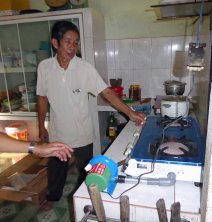

Plant matter is not the only biomass that can be used to create methane. On the two other farms we visited, we learned that farmers can also use manure from a variety of animals including pigs and snakes. Experiencing first-hand how innovative and creative these farmers are in making their farms more self-sustainable is inspiring.
 With ever changing conditions, both in the environment as well as in the economy, farmers in the Mekong Delta must adapt to survive. The great example we saw today of this adaptation in action, shows me that change can be positive and environmentally friendly.
With ever changing conditions, both in the environment as well as in the economy, farmers in the Mekong Delta must adapt to survive. The great example we saw today of this adaptation in action, shows me that change can be positive and environmentally friendly.
‘Amateur’ Hour: the Musical Tradition of Vietnam
‘Amateur’ Hour: the Musical Tradition of Vietnam
By Maggie Gammons
 I’ve always loved the way folk music brings people together. It is an art form passed down through generations, amongst friends, and across cultures. Folk music is more than music alone—it includes costumes, language, dance, and stories. Best of all, folk music is for everyone, whether playing, singing, dancing, or just clapping along.
I’ve always loved the way folk music brings people together. It is an art form passed down through generations, amongst friends, and across cultures. Folk music is more than music alone—it includes costumes, language, dance, and stories. Best of all, folk music is for everyone, whether playing, singing, dancing, or just clapping along.
As a living artifact, folk music offers a unique window with which to view a culture. Vietnam’s traditional music is a beautiful example, and it embodies a colorful cross-section of the nation itself.  It has been shaped by the same mixture of cultures that make up its population: a combination of Kinh (Vietnamese), Hoa (Chinese), Khmer (Cambodian), and Cham (Austronesian) peoples. These cultures merged to form the Vietnamese culture and its modern written language. In the 1800s, foreign influence came from the West, as the French occupied the country under colonial rule. With the French came new architecture, religion, and, of course, music.
It has been shaped by the same mixture of cultures that make up its population: a combination of Kinh (Vietnamese), Hoa (Chinese), Khmer (Cambodian), and Cham (Austronesian) peoples. These cultures merged to form the Vietnamese culture and its modern written language. In the 1800s, foreign influence came from the West, as the French occupied the country under colonial rule. With the French came new architecture, religion, and, of course, music.
All of these influences (and countless others) have shaped the traditional music that exists in Vietnam today. Since I arrived here a week ago, I have had the privilege of hearing two different types of music—Hó and Don Ca Tai Tu, or Southern ‘Amateur’ Music—which I would like to share about here.
Hò
Hó (pronounced “ha”) is a form of vocal music used to express love. It’s typically sung as a dialog between a man and a woman, alternating verses. The songs are short and simple, and are sung by elongating the last vowel in each line. Each province in the south has a different type of Hó which celebrates its natural beauty and unique culture. Here is a video of Can Tho’s Hó song, performed by a woman in a tea house in Ho Chi Minh City: https://youtu.be/OwIvL03lmb4


Đờn ca Tài tử (Southern ‘Amateur’ Music)
I feel the need to put the word ‘amateur’ in quotation marks, because the skill displayed in this type of music is anything but novice.
 Đờn ca Tài tử is an instrumental tradition which typically features a singer and four instruments: Dan Co (two-stringed fiddle), Dan Kim (two-stringed lute), Dan Bau (one-string zither), Dan Guitar Phim Lom (concave-fret guitar). Like Hó, ‘Amateur’ Music was intended to reflect the lifestyle of the musicians and fit in with their daily activities.
Đờn ca Tài tử is an instrumental tradition which typically features a singer and four instruments: Dan Co (two-stringed fiddle), Dan Kim (two-stringed lute), Dan Bau (one-string zither), Dan Guitar Phim Lom (concave-fret guitar). Like Hó, ‘Amateur’ Music was intended to reflect the lifestyle of the musicians and fit in with their daily activities.  This type of music can be performed in either formal or informal settings, and either after work or during work. It is enjoyed by many today, and in 2014, UNESCO recognized Don Ca Tai Tu as an intangible cultural heritage of Vietnam.
This type of music can be performed in either formal or informal settings, and either after work or during work. It is enjoyed by many today, and in 2014, UNESCO recognized Don Ca Tai Tu as an intangible cultural heritage of Vietnam.

Curved frets on Dan Guitar Phim Lom
To begin each song, the musicians take a moment to tune and warm up together. When the song begins, the players follow the beat kept on a foot percussion instrument. Once the melody has been stated, the musicians begin to improvise and embellish the song, adding their own emotions and ideas. If there is a singer, he or she will use expressive movements and facial expressions to tell a story. Here is a video of the Amateur Music we saw in Can Tho: https://youtu.be/SveSh5cjQwo
 These are just two examples of the lively traditional music of Vietnam. There is so much to love and learn about, and I’ve only begun to scratch the surface. I can’t wait to spend the rest of my time here with my ears wide open, listening to Vietnam’s culture through the songs of its past.
These are just two examples of the lively traditional music of Vietnam. There is so much to love and learn about, and I’ve only begun to scratch the surface. I can’t wait to spend the rest of my time here with my ears wide open, listening to Vietnam’s culture through the songs of its past.
Changing Vietnam’s Environmental Attitudes Through ChangeVN
By Brielle Birgensmith
On December 29, our group from the University of Montana met with Ms. Nhi Thoi, the Program Manager for an environmental nonprofit organization called ChangeVN. Our meeting was held at the Nha Hang Viet Heritage restaurant in Ho Chi Minh City.  Prior to Ms. Nhi Thoi’s presentation I knew very little about how nonprofit organizations worked in Vietnam. Going into this program, I was briefly informed of various environmental issues Vietnam has been facing and I wanted to learn more about how citizens were responding to these issues. Aware that Vietnam is a socialist republic with a one party system led by the Communist Party of Vietnam (CPV), I hoped to better understand how nonprofit organizations worked within the country. Our meeting with Ms. Nhi Thoi was able to answer all of my questions above and beyond.
Prior to Ms. Nhi Thoi’s presentation I knew very little about how nonprofit organizations worked in Vietnam. Going into this program, I was briefly informed of various environmental issues Vietnam has been facing and I wanted to learn more about how citizens were responding to these issues. Aware that Vietnam is a socialist republic with a one party system led by the Communist Party of Vietnam (CPV), I hoped to better understand how nonprofit organizations worked within the country. Our meeting with Ms. Nhi Thoi was able to answer all of my questions above and beyond.
NGOs in Vietnam are not fully independent from their government. They must submit their activities to the CPV for approval, and must apply for permits that are reviewed through four different ministries.  ChangeVN has been in Vietnam since 2009 but initially was not legally registered and worked under another organization that was licensed. Now, ChangeVN is registered under the Vietnam Union of Science and Technology Association.
ChangeVN has been in Vietnam since 2009 but initially was not legally registered and worked under another organization that was licensed. Now, ChangeVN is registered under the Vietnam Union of Science and Technology Association.
The Change in ChangeVN stands for Center for Hands-On Actions and Networking for Growth and Environment. Founded in 2013 by the first Vietnamese to set foot in Antarctica, ChangeVN is one of the few environmental NGOs based in Ho Chi Minh City (most are headquartered in Hanoi where the government ministries are located). Currently, ChangeVN has 10 full time employees as well as various interns. Their mission is to promote and encourage the care and preservation of the environment through education and innovative communications that change habits and inspire community action in Vietnam. ChangeVN focuses on three main environmental issues, which are wildlife trade, climate change and sustainability. Here I focus primarily about their work related to climate change.
ChangeVN focuses on communication aspects of climate change. This includes outreach and education to promote clean energy sources in the community.  They have completed a number of projects throughout the last several years. In 2013, they conducted a three-phase power shift campaign in Vietnam. The first phase was nationwide. Ms. Nhi Thoi informed our group that the majority of their projects are funded by foreign donations. The second phase was to target Ho Chi Minh City and lastly to reach out to various cities and provinces outside of Ho Chi Minh. ChangeVN also work to train youth in becoming climate leaders. In 2014, they created ‘Black Day’ to mobilize youth and artists in raising awareness on coal impacts on human health and environment. In 2015, they organized a Divestment Day that directly pressured Japan to stop financing coal in Vietnam.
They have completed a number of projects throughout the last several years. In 2013, they conducted a three-phase power shift campaign in Vietnam. The first phase was nationwide. Ms. Nhi Thoi informed our group that the majority of their projects are funded by foreign donations. The second phase was to target Ho Chi Minh City and lastly to reach out to various cities and provinces outside of Ho Chi Minh. ChangeVN also work to train youth in becoming climate leaders. In 2014, they created ‘Black Day’ to mobilize youth and artists in raising awareness on coal impacts on human health and environment. In 2015, they organized a Divestment Day that directly pressured Japan to stop financing coal in Vietnam. Another campaign in 2016 called “I Can’t” aimed to illustrate the deadly effects of coal through creating a number of dramatic posters starring famous Vietnamese people. In 2017, ChangeVN produced public service announcements (PSAs) in the form of street art.
Another campaign in 2016 called “I Can’t” aimed to illustrate the deadly effects of coal through creating a number of dramatic posters starring famous Vietnamese people. In 2017, ChangeVN produced public service announcements (PSAs) in the form of street art.
I was very grateful to have learned about this unique nonprofit organization that brings awareness of environmental issues in Vietnam as well as hear how passionate Ms. Nhi Thoi was to be working with ChangeVN.
Motorbikes and Urban Transportation in Vietnam
By Casey Brandon
One of the first things I was told before I traveled to Vietnam was to be careful crossing the streets. In Southeast Asia, traffic is not the same as we are accustomed to in America. The taxi ride from the airport to the hotel made it clear to me that I was very far from home.  The sound of horns honking filled the air, motorbikes whizzed by, and multiple times we came so close to hitting others on the road that I had to close my eyes and take a few deep breaths. Having been in Vietnam for a few days now, I feel much more comfortable crossing and navigating the city streets, so much so that I worry American traffic laws will annoy me. The best way I could think to describe traffic and urban transportation here in Vietnam would be organized chaos. To us Westerners, it appears to be pure madness, but after a few days one will come to recognize that it works quite well. One of the reasons for this is the lack of cars, and to fill in for these cars the country drives motorbikes.
The sound of horns honking filled the air, motorbikes whizzed by, and multiple times we came so close to hitting others on the road that I had to close my eyes and take a few deep breaths. Having been in Vietnam for a few days now, I feel much more comfortable crossing and navigating the city streets, so much so that I worry American traffic laws will annoy me. The best way I could think to describe traffic and urban transportation here in Vietnam would be organized chaos. To us Westerners, it appears to be pure madness, but after a few days one will come to recognize that it works quite well. One of the reasons for this is the lack of cars, and to fill in for these cars the country drives motorbikes.
 When a typical American family has their second kid, a common inclination is to purchase a good ol’ minivan (stereotype). Here in Vietnam, however, families of four will drive around town on a single motorbike, child in front, father driving, mom holding a baby in the back. There are pros and cons to this stark difference from urban transportation in America.
When a typical American family has their second kid, a common inclination is to purchase a good ol’ minivan (stereotype). Here in Vietnam, however, families of four will drive around town on a single motorbike, child in front, father driving, mom holding a baby in the back. There are pros and cons to this stark difference from urban transportation in America. 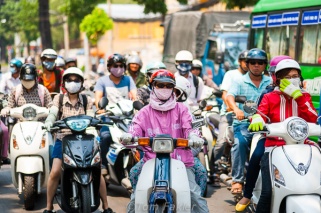 If everybody in Vietnam drove a car like most Americans do, the traffic would be unbearable and the air would be unbreathable. Hanoi and Ho Chi Minh City, the two biggest cities in Vietnam, already struggle with air pollution. Most citizens wear face masks to protect themselves from the exhaust pollution that already fills the air. As of 2016, Ho Chi Minh City alone has over 7 million motorbikes; the population of the city is just over 8 million. This is putting serious pressure on Vietnam’s transportation infrastructure. Replacing motorbikes with cars simply cannot happen.
If everybody in Vietnam drove a car like most Americans do, the traffic would be unbearable and the air would be unbreathable. Hanoi and Ho Chi Minh City, the two biggest cities in Vietnam, already struggle with air pollution. Most citizens wear face masks to protect themselves from the exhaust pollution that already fills the air. As of 2016, Ho Chi Minh City alone has over 7 million motorbikes; the population of the city is just over 8 million. This is putting serious pressure on Vietnam’s transportation infrastructure. Replacing motorbikes with cars simply cannot happen.
Not too long ago, boats were the primary form of transportation for many Vietnamese, especially in the Mekong Delta.  However, just like the country as a whole, this is rapidly changing and developing.
However, just like the country as a whole, this is rapidly changing and developing. 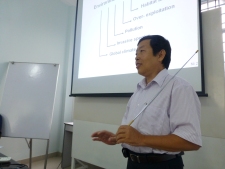 Dr. Duong Van Ni, a professor from Can Tho University, says that this is because Vietnam is following the track of other developing countries. As Vietnam attempts to compete in the world market, they are increasingly forced to adhere to the wishes of big foreign investors and countries. Japan, for example, would love to see Vietnam build more roads, so that they can sell more of their cars, such as Toyota, Honda and Mazda, to name a few. Currently, car sales come with an extremely hefty tax, whereas motorbikes have none, but this could always change.
Dr. Duong Van Ni, a professor from Can Tho University, says that this is because Vietnam is following the track of other developing countries. As Vietnam attempts to compete in the world market, they are increasingly forced to adhere to the wishes of big foreign investors and countries. Japan, for example, would love to see Vietnam build more roads, so that they can sell more of their cars, such as Toyota, Honda and Mazda, to name a few. Currently, car sales come with an extremely hefty tax, whereas motorbikes have none, but this could always change.
As of 2001, helmets are now mandatory for all bikers. However, according to the World Health Organization, approximately 14,000 road traffic deaths occur each year in Vietnam, with the majority being motorcyclists.  This is the result of high population mixed with poor enforcement of traffic laws. However, having ridden a motorbike for the first time during this trip, I must say it is quite fun. I see both the negatives and the positives to transportation in Vietnam. As the country continues to develop and citizens become more affluent, it will be interesting to see how their transportation infrastructure changes. One can only hope it remains primarily motorbikes in lieu of cars.
This is the result of high population mixed with poor enforcement of traffic laws. However, having ridden a motorbike for the first time during this trip, I must say it is quite fun. I see both the negatives and the positives to transportation in Vietnam. As the country continues to develop and citizens become more affluent, it will be interesting to see how their transportation infrastructure changes. One can only hope it remains primarily motorbikes in lieu of cars. 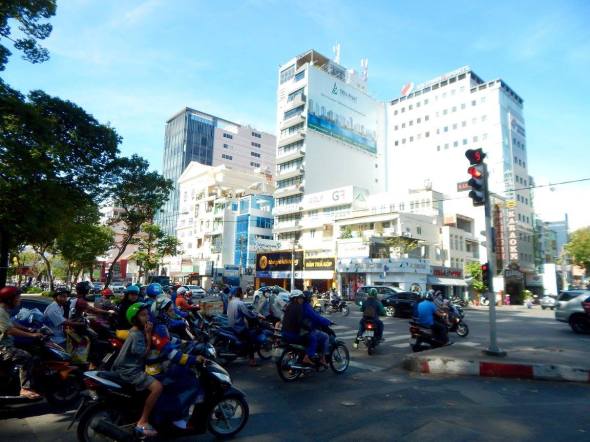
Mangrove Restoration at Can Gio Mangrove Biosphere Reserve
By Elissa Chott
 Our class spent New Year’s Eve outside Saigon at the Can Gio Mangrove Reserve wading through calf-deep mud past crabs and mudskippers, digging holes to be filled with mangrove saplings.
Our class spent New Year’s Eve outside Saigon at the Can Gio Mangrove Reserve wading through calf-deep mud past crabs and mudskippers, digging holes to be filled with mangrove saplings.  Defoliants used by Americans in the 1960’s and 1970’s destroyed all the mangroves in the region, devastating the forests beyond recognition. Mangroves fulfill important ecological services including protecting the coastline from storms and erosion, providing habitat for wildlife, cleansing soil toxins, creating a pollution sink, and entrapping sediment from upland runoff. Many livelihoods in the region depend on resources harvested from the rivers and coastal areas in which mangrove forests thrive. Realizing the need for both ecological diversity and human resource use, restoration efforts began in 1978 by transferring seedlings from the mangroves in Ca Mau (to the south) to replant the moonscape forests of Can Gio.
Defoliants used by Americans in the 1960’s and 1970’s destroyed all the mangroves in the region, devastating the forests beyond recognition. Mangroves fulfill important ecological services including protecting the coastline from storms and erosion, providing habitat for wildlife, cleansing soil toxins, creating a pollution sink, and entrapping sediment from upland runoff. Many livelihoods in the region depend on resources harvested from the rivers and coastal areas in which mangrove forests thrive. Realizing the need for both ecological diversity and human resource use, restoration efforts began in 1978 by transferring seedlings from the mangroves in Ca Mau (to the south) to replant the moonscape forests of Can Gio.
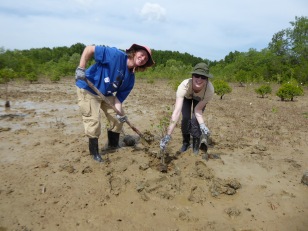 A sparsely vegetated field of dense, slippery clay once functioning as a salt farm is being restored to a mangrove forest one volunteer group at a time. Our class toted spades and saplings across the slick surface and dug holes one square meter apart. The mud created fantastic sound effects as shovels were hefted through the thick clay. Crabs went scuttling off as mudskippers leapt out of the way from under rubber boots. Mangroves will die if the mud is tamped down around their root system, so after placing a sapling in its new home, mud is carefully filled in around the small clod of soil protecting the roots. In a matter of a sweaty and muddy hour, the field had several dozen new mangroves.
A sparsely vegetated field of dense, slippery clay once functioning as a salt farm is being restored to a mangrove forest one volunteer group at a time. Our class toted spades and saplings across the slick surface and dug holes one square meter apart. The mud created fantastic sound effects as shovels were hefted through the thick clay. Crabs went scuttling off as mudskippers leapt out of the way from under rubber boots. Mangroves will die if the mud is tamped down around their root system, so after placing a sapling in its new home, mud is carefully filled in around the small clod of soil protecting the roots. In a matter of a sweaty and muddy hour, the field had several dozen new mangroves.
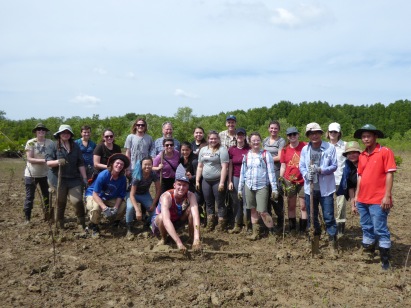 Protection for the Can Gio Reserve is organized into Forest Management Units and coordinated between the Hamlets People Committee, farmers, local police, and border police. Households oversee management at a local level to ensure sustainable fishing and farming practices are followed.
Protection for the Can Gio Reserve is organized into Forest Management Units and coordinated between the Hamlets People Committee, farmers, local police, and border police. Households oversee management at a local level to ensure sustainable fishing and farming practices are followed.  This nested management system is useful to provide on the ground monitoring of resources, but enforcement is sometimes difficult. Mangrove harvesting is prohibited in all management units to facilitate growth and continued recovery, but farming and fishing are allowed at sustainable levels. Mangrove growth increased in the past 10 years due to widespread restoration efforts and aid from international groups.
This nested management system is useful to provide on the ground monitoring of resources, but enforcement is sometimes difficult. Mangrove harvesting is prohibited in all management units to facilitate growth and continued recovery, but farming and fishing are allowed at sustainable levels. Mangrove growth increased in the past 10 years due to widespread restoration efforts and aid from international groups.
As a result of vigorous forest restoration practices, Can Gio Reserve now boasts diversity of:
157 species of plants
100 species of invertebrates
137 species of fish
31 species of reptiles
19 species of mammals
130 species of birds![Chott 5[1]](https://umvietnamstudy.files.wordpress.com/2018/01/chott-511.jpg?w=336&h=252)
We visited a 58 hectare shrimp farm within the mangrove forest management units. Government subsidies compensate the farmer per hectare for conserving the forests. This income is in addition to that received from his shrimp harvests and inviting tourists to visit his farm. Bimonthly lunar tides bring young shrimp and fish into his ponds through sluice gates where they grow to harvestable size. When the second monthly tide recedes, he catches the shrimp and fish on their way downriver, returning those too small to sell into the pond to grow larger. In the face of climate change and severe reduction of shoal size resulting in unsustainable harvests, the farmer stated he would be forced to move from his property in the forest and find other income.  As the mangrove forests recover and increase in area, the acreage he has available to farm diminishes. Since he is contracted within the forest management zone, mangrove harvests are not allowed and there must be 100% forest coverage. While the future of his livelihood is uncertain, his current conservation efforts and those of restorationists are enabling the coastal ecosystem to flourish in an area once devoid of both flora and fauna.
As the mangrove forests recover and increase in area, the acreage he has available to farm diminishes. Since he is contracted within the forest management zone, mangrove harvests are not allowed and there must be 100% forest coverage. While the future of his livelihood is uncertain, his current conservation efforts and those of restorationists are enabling the coastal ecosystem to flourish in an area once devoid of both flora and fauna.

You must be logged in to post a comment.